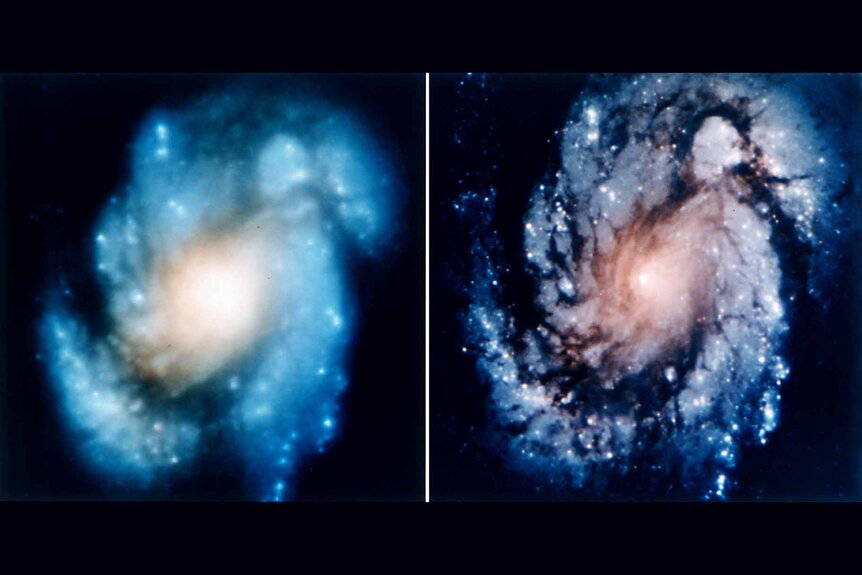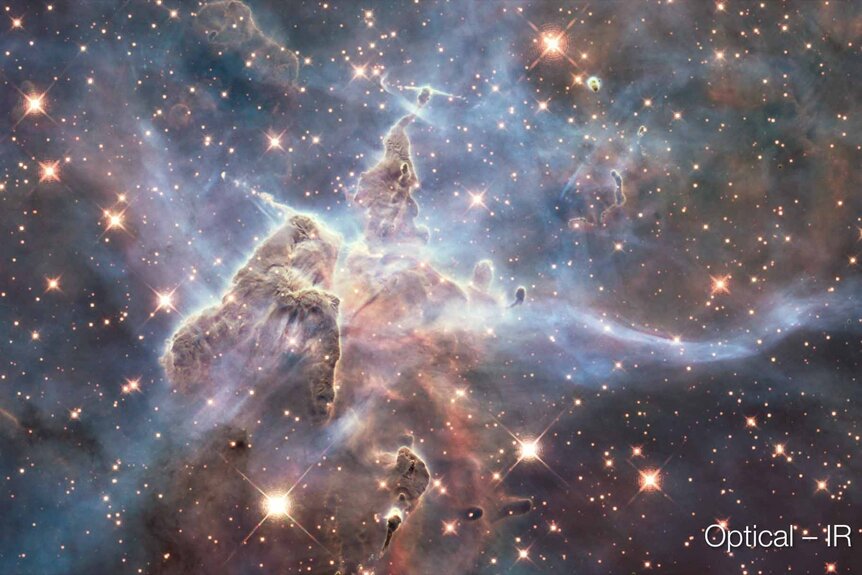Create a free profile to get unlimited access to exclusive videos, sweepstakes, and more!
Did NASA Really Find Heaven? That Viral TikTok Claim Explained
Pretty sure that's not how telescopes work.
When it comes to outer space, we’ve learned to expect the unexpected. Every time we think we have a handle on what’s out there and how it all works, we build a new telescope or figure out some new technique and reality gets a little bit weirder.
In 1994, an alleged Hubble image was published alongside a report that NASA scientists had discovered the “City of God” in deep space. If you’re feeling skeptical, that’s good and correct. We like to imagine brave explorers like the crew of The Ark, nobly seeking out new worlds in deep space, despite the danger. When compared with other occupations, leaving the planet has a higher-than-average likelihood of ending in death, but if an astronaut is headed for the afterlife they don’t expect to fly there direct. Or do they?
A viral video making the rounds on TikTok has resurrected the 30-year-old image of God’s heavenly hangout. Just to be clear right up front, the image is fake, but let’s get into how we know that it’s fake and not part of an elaborate government cover up.
For More on Hubble:
Hubble and JWST Join Forces to Create Most Colorful View of the Cosmos Ever
See What the Hubble Space Telescope Saw on Your Birthday
Hubble Captured a Supernova at Three Different Ages in One Image
The First Time Hubble “Saw Heaven”
The modern popular image of the cosmos was largely defined by the Hubble Space Telescope and its awe-inspiring views of the universe. Hubble launched aboard the space shuttle Discovery on April 24, 1990 and was deployed the following day. Pretty quickly, NASA realized that there was a defect in the primary mirror, causing the images to come in blurry. Despite that, Hubble started sending back images of nearby planets and distant cosmic objects, and astronomers got busy rewriting our understanding of existence.
In December 1993, astronauts carried out the first Hubble servicing mission. They installed instruments and updates designed to correct for the flawed mirror. After installation, the clarity of Hubble images was dramatically improved. At the time, Hubble was the most powerful orbital telescope in existence, and it allowed us to investigate the nature of the universe like never before. Humanity was being granted an unprecedented view of the heavens and we were primed for world-shattering discoveries.
RELATED: Hubble spies what may be a rogue black hole just 5,000 light years away
The TikTok in question claims that NASA actually found heaven with the Hubble Space Telescope back in 1994, shortly after repairs were completed. All of the video’s claims come in the form of a voiceover, which itself is based on information the narrator allegedly received from their uncle, who allegedly worked for NASA. Already, we have to make a lot of concessions to believe what we’re being told. It’s not passing the sniff test, but let’s keep going.
Over the course of nearly five minutes, we're told that this image of a heavenly building is a confirmed NASA leak and that the organization attempted to bury the truth about it. None of that is true, of course, even if the video’s narrator really does have an uncle who works at NASA.
People have been claiming that NASA found evidence of some religious tradition or another for decades. As soon as scientists really started digging into the clockwork of the universe, people started claiming to find evidence of the divine.
No, NASA Didn’t Take Pictures of Heaven with the Hubble Space Telescope (or Any Other Telescope)
In 2016, an image started circulating online reported to feature the gates of heaven nestled into a nebula. Captions featured the usual claims that scientists were stymied by what they had found, but that wasn’t true, because the image was fake. More accurately, it was a work of art that was later co-opted to sell a religious story online. The image was one of a number of similar works by Adam Ferriss, an artist known to use a pixel sorting process to create art out of Hubble images. Ferriss began with an actual Hubble image of Messier 17, the Swan Nebula, and created the so-called gates of heaven by sorting the pixels to create stacks. Ferriss never made any claims of legitimacy about his work, but it was later picked up by third parties who attached the heaven’s gate narrative.
At least those posters had the good sense to pick up a new image and spin a new story. The recent viral video on the City of God image couldn’t even do that. Instead, it recycles a story from 1994, one that everyone knew was fake when it hit newsstands 30 years ago. The image was originally published in a Weekly World News story called “Heaven Photographed by Hubble Telescope.” The story was republished online in 2009. For those of you who don’t remember Weekly World News, it was a supermarket tabloid concerned with half-bat, half-human hybrids and figuring out whether you were descended from aliens. You bought Weekly World News for the chuckles, not because it was telling you the truth they didn’t want you to know.
The story is built on a tenuous foundation of truth. It begins talking about Hubble’s recent repairs, the ones which corrected the mirror defect, and the first clear images taken afterward. Allegedly, astronomers pointed Hubble at “the edge of the universe” and saw a brilliant celestial city floating in space. The image, like the magazine itself, is in black and white. It shows what looks like a distant city, or maybe a large house on a hill, set against a dark, star-speckled sky.
Spikes of light sprawl from the edges of the city, stretching out into space at odd angles. It helps to sell the image, giving the city a heavenly look, but it also reveals its artificial nature. Because the spikes are all wrong. You’ve probably noticed, when looking at images from Hubble or the James Webb Space Telescope (JWST) that bright objects like stars have characteristic spires of light spread out around them. You might also have noticed that the spikes visible in Hubble images are different from the spikes in JWST images, and there’s a reason for that.
RELATED: Psst! Wanna see an actual Hubble image of a planet forming around a nearby star?
Diffraction spikes are a key feature of images taken with mirror-based telescopes. Light collected by the primary mirror gets distorted a little bit, both from interacting with the mirror itself and from passing by the support struts. When looking at large, diffuse objects the distortion is small enough that it’s not really noticeable. When looking at stars, however, the high concentration of bright light causes distinct spikes. Importantly, diffraction spikes are artifacts of the telescope’s structure, they are not representative of the object being observed, which means we can determine whether a particular image was taken by a particular telescope from the pattern of spikes.
Right off the bat, the scattered nature of the spikes in the picture of heaven doesn’t make sense. There are roughly a dozen spikes splayed out in all directions but favoring the left side. The diffraction spike pattern doesn’t match Hubble or any other orbital telescope. Hubble’s diffraction spikes (which you can see in the actual Hubble image, above) come in the form of a simple cross, paired horizontal and vertical spikes. There are only four and they always splay out at 90-degree angles to one another. That doesn’t prove the story or that the image is fake, but it does prove Hubble didn’t capture it.
The rest of the story falls apart if you pull its threads even a little. It hinges on the comments of author and researcher Dr. Marcia Masson. The thing is, there is no record of Dr. Masson in the scientific literature, doing astronomical work at the time of the alleged photo’s release or at any other time.
Every other claim in the story including that then-President and Vice President Bill Clinton and Al Gore had “taken a deep personal interest” in the photo and that scientists were forced to conclude that “the only logical explanation was that the city was inhabited by the souls of the dead” and “we found where God lives,” come from unnamed NASA sources.
Of course, maybe that’s all just a part of the cover up.
The story of The Ark is currently in stasis but returns for Season 2 on SYFY later this year! Who knows what they'll find. In the meantime, catch a wide selection of science fiction streaming now on Peacock.
































